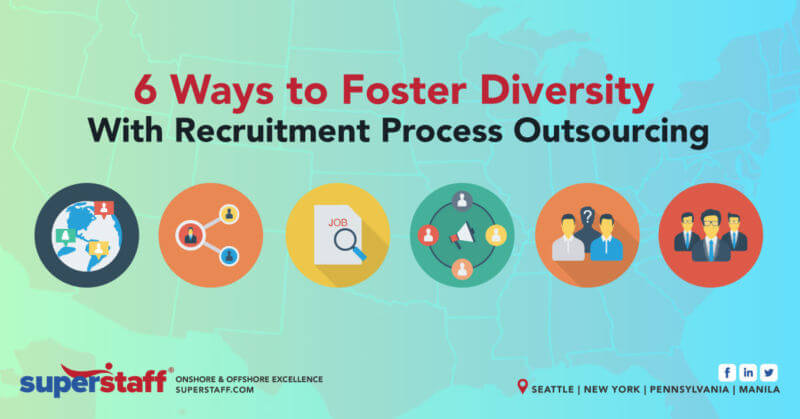
The numbers have spoken: Diversity and inclusion matter in business. And building a work environment that welcomes and celebrates diversity starts with hiring the right people.
According to a McKinsey study, companies that prioritized racial and ethnic diversity were 35% more likely to receive higher financial returns compared to other businesses in the same industry. Meanwhile, companies high in gender diversity were 15% more likely to perform better financially than others in their industry.
In this article, we’ll take a closer look at the importance of diversity in the workplace. Then, we’ll cover some helpful recruitment tips on how you can build a more diverse workforce, including how recruitment process outsourcing can help!
Importance of Diversity and Inclusion in the Workplace
Diversity and inclusion (D&I) are the policies and strategies put in place by a company to ensure that employees from different backgrounds, orientations, and identities are present in the workplace and feel valued. Ideally, a diverse and inclusive workplace will allow everyone to contribute meaningfully and present their different perspectives.
One example of a company that has successfully implemented diversity and inclusion into its work culture is Apple Inc., one of the most well-known and enduring tech giants. By listening to the varied perspectives of their employees and app developers and including them in decision-making and strategy building, Apple can continually come up with new ideas and diverse ways of seeing things.
Deloitte’s research confirms these benefits, finding that companies that encourage diversity of thinking improve their creativity and innovation by 20%. Diversity also enables better decision-making, reducing risk by up to 30%.

6 Must-Know Recruitment Tips for Creating a Diverse and Inclusive Workforce (and How Recruitment Process Outsourcing Helps!)
Now that we understand the importance of diversity and inclusion in business, let’s talk about how you can start creating a more inclusive workplace, starting at the beginning: recruitment.
#1: Identify Benchmarks for Diversity and Inclusion
If you want to start building a more diverse and inclusive workplace, begin with identifying benchmarks. These measurements are critical for creating strategic plans of action that will help you improve.
One sample benchmark could be increasing the percentage of minority hires within a specified period. For instance, you can increase the number of qualified female tech-related roles by [x percent] within six months. Adding more visible racial minorities to your sales team is also a good start. Increasing the percentage by [x percent] within a year could also be a realistic and actionable benchmark.
For some businesses, working with RPO companies can make this process easier. Many RPO providers utilize data analytics to help organizations identify the gaps in their D&I policies more easily and effectively, set realistic benchmarks, and then hire the right talent within the set timeline.
#2: Encourage Referrals From Your Diverse Employees
One way to improve the diversity of your workforce is by encouraging diverse employees to refer qualified talents. Implementing employee referral programs to foster diversity and inclusion can bring significant advantages, helping you reduce hiring time and eliminate extra screening tests while showing diverse workers that their input and feedback matter to you.
Current employees will feel valued and trusted since they are participating in the company’s growth. Meanwhile, referred employees will feel more comfortable and engaged because they will already know at least one person in the organization.
#3: Remove Bias in Job Descriptions, Interviews, and Assessments
Whether consciously or unconsciously, the language and methods used in the hiring process can often be biased and unfair, which often hinders diversity and inclusion. Thankfully, there are steps businesses can take to recognize and reduce these biases.
One significant step is by reworking your job descriptions. Craft powerful job advertisements that focus on work experiences and skills, taking care to remove biased language.
According to the Harvard Business Review, even subtle word choices can impact the kind of talent your job ads attract. For example, words like “competitive” and “determined” tend to attract more men, while “collaborative” and “cooperative” draw in more women. To reduce bias, switch to more neutral descriptors or use software programs that identify stereotypically gendered words so you can avoid them.
In addition, businesses can implement standardized interviews and assessment tests, which reduce gender or racial bias in interviews and focus on merit, skills, and achievements. With help from the right recruitment process outsourcing provider, you can ensure that your hiring process will be as fair and unbiased as possible.
#4: Seek Out Diversity-Oriented Organizations and Groups
Sometimes, the most efficient and effective way to improve the diversity and inclusion of your organization is by seeking out groups that focus on diversity. For instance, you can try posting in diversity-oriented job groups, partnering with diversity organizations, and connecting with diversity-oriented groups at universities. Also, consider expanding your college recruitment strategy to include more diverse schools.
When you hire a recruitment process outsourcing provider, they can help you with this process, allowing you to focus on your core competencies as they handle your hiring and recruitment needs. Professional RPO companies will typically know which groups and organizations to reach out to and connect with to find qualified and diverse candidates for specific roles.
#5: Implement “Blind Hiring”
Here’s another strategy that helps avoid bias in the recruitment process: consider blind hiring. This technique anonymizes personal information about a candidate, often unrelated to job performance, which might lead to personal bias on the part of the hiring manager or recruiter.
For instance, some recruitment technologies can remove candidate names, photos, university names, or other personal information from a resume or online profile. Other blind hiring practices may include pre-hire tests to assess job-related skills and knowledge. A reliable RPO provider can help businesses implement blind hiring techniques that highlight the most qualified candidates, regardless of gender, age, or race.
#6: Create a Recruitment Team That Advocates for Diversity and Inclusion
If diversity and inclusion are a top priority for your organization, making sure that your recruitment team advocates for these would be critical. Ideally, your recruitment team will also be composed of diverse individuals, so hiring bias can be reduced. With this, candidates with different backgrounds can feel greater ease and engagement during the recruitment process.
When you opt for recruitment process outsourcing, choose a provider that cares about cultivating a quality, diverse workforce that will be wonderful additions to your growing business.
Partner With a Recruitment Process Outsourcing Provider That Makes Diversity a Priority!
Ready to start building a diverse workplace that fosters new ideas, inspires innovation, and improves your bottom line? SuperStaff is here to help!
At SuperStaff, we offer innovative recruitment process outsourcing services that can help you find the qualified talent you need at the timeline you set. Just like you, our professional team cares about creating a diverse and inclusive work environment. Let’s talk about the ways our RPO solutions can empower your business to reach new heights!






